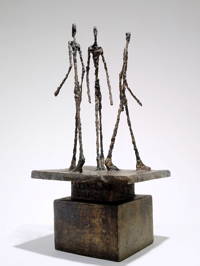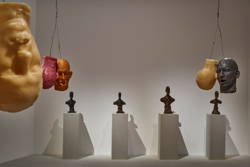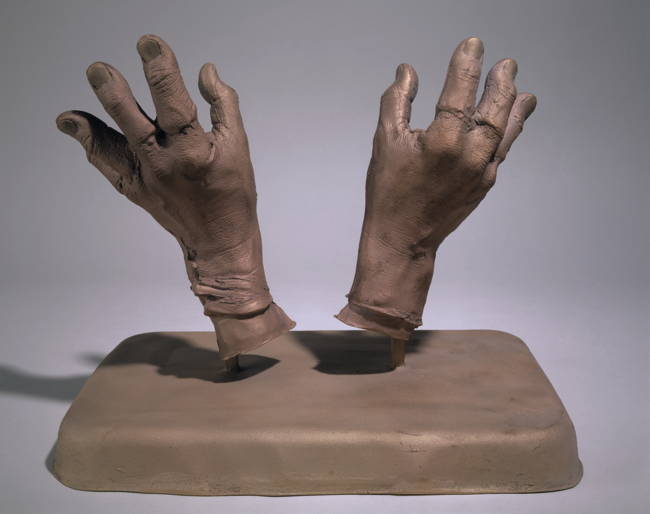Giacometti (1901–1966) is regarded as one of the most important classical modern European sculptors. Nauman (born in 1941) and his multifaceted oeuvre represent the radical upheavals in contemporary art since 1960 and a concept of sculpture liberated from traditional concepts. Featuring some 70 works in all, this is the first exhibition ever devoted to both.
 Alberto Giacometti, Groupe de trois hommes I, 1943. Fondation Marguerite et Aimé Maeght, Saint-Paul - France © Alberto Giacometti Estate (Fondation Alberto et Annette Giacometti + ADAGP) Paris, 2016
Sculptures and paintings by the Swiss artist engage in a fascinating dialogue with videos, sculptures, drawings, photographs, and spatial installations by the US multimedia artist. Giacometti is represented by works from nearly all of his important creative phases, Nauman primarily by his early oeuvre from the 1960s and early 1970s, which followed immediately on the heels of Giacometti’s works. Although the two artists never met and never referred explicitly to each other, they have a great deal in common. Both revolutionized the concepts and traditions of sculpture from the perspective of their respective times—Giacometti during the first half of the twentieth century, and Nauman from the 1960s to the present. Both are regarded as individualists who worked consistently from a position of self-imposed isolation and loneliness that has left an indelible imprint on their uncompromising art.
A common search for artistic truth
Both represent utterly radical artistic standpoints, and both have created works of shocking immediacy that pose lasting challenges for viewers. Giacometti and Nauman have ventured with their oeuvres into uncharted regions of art and perception. Their search for artistic truth is a quest, the outcome of which is often manifested in the creative process itself rather than in finished works. The two artists have elevated failure, the absurd, the fragmentary, and the unheroic to the status of essential elements of their art. The art of both Giacometti and Nauman revolves around the human being. Giacometti was concerned consistently and almost exclusively with the human figure in his sculptures and paintings, and he developed an original human image of his own with his unmistakable style of figuration, especially during the years after 1945. Bruce Nauman’s work during the 1960s and 1970s was focused above all on the human body (primarily his own), which he took as the point of departure for an investigation into fundamental questions about human nature and the conditions governing human existence.
 GIACOMETTI-NAUMAN, exhibition view © Schirn Kunsthalle Frankfurt, 2016, Photo: Norbert Migulet
The exhibition enhances our grasp of the oeuvres of two outstanding representatives of the art of the twentieth and twenty-first centuries. Giacometti becomes recognizable as a pioneer who paved the way for important developments in art after the 1960s and regains certain aspects of his original radical artistic position, whereas Nauman’s outstanding importance as a sculptor is made clear and historically comprehensible in a different way. The exhibition at the Schirn presents works from leading museums and collections in the United States and Europe, including the Guggenheim Museum in New York, the San Francisco Museum of Modern Art, the Walker Art Center in Minneapolis, the Hirshhorn Museum and Sculpture Garden in Washington, D.C., the Tate in London, the Centre Pompidou in Paris, the Fondation Alberto et Annette Giacometti in Paris, the Fondation Marguerite et Aimé Maeght in Saint-Paul-de-Vence, the Louisiana Museum of Modern Art in Humlebæk, the Fondation Beyeler in Basel/Riehel, the Lehmbruck Museum in Duisburg, the Neue Nationalgalerie in Berlin, and the Hamburger Kunsthalle.
PUBLICATIONS AND TUTORIAL
• CATALOGUE
Edited by Esther Schlicht. Foreword by Philipp Demandt. Essays by Esther Schlicht, Gaby Hartel, Thierry Dufrêne, and Robert Storr. German/English edition, 184 pages, approx. 150 illustrations, 30 x 23 cm (portrait format), softcover, Snoeck, Cologne, 2016, ISBN 978-3-86442-180-8, Schirn edition: 35 €, in bookstores 39.90 €.
• BOOKLET
Edited by Schirn Kunsthalle Frankfurt, texts by Laura Heeg and Olga Shmakova, German edition, approx. 36 pages, colour images, cut flush binding; design by formfellows, Frankfurt; Rasch Druckerei und Verlag, (Bramsche, 2016), € 7.50, classroom set available for € 1 per booklet (15 or more).
• TUTORIAL
The free digitorial provides you with background information about the key exhibition aspects. It is responsive and can be accessed in German and English online under www.schirn.de/digitorial/en.
It combines multimedia contents in the form of images, videos, sound, and texts and presents them in an innovative format accompanied by appealing narration. For desktop, tablet and mobile.
|



